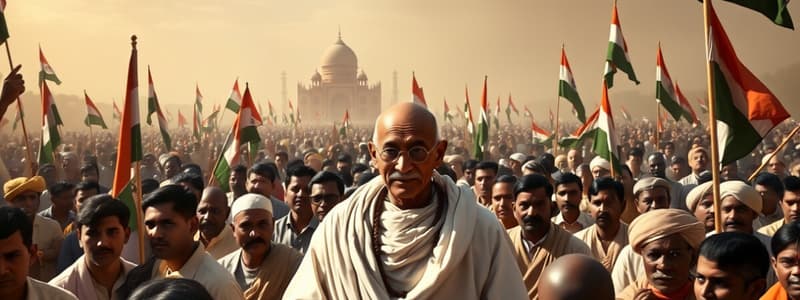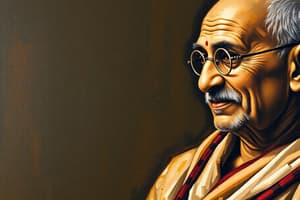Podcast
Questions and Answers
In December 1931, Gandhiji went to ______ for the conference.
In December 1931, Gandhiji went to ______ for the conference.
London
Many nationalists thought that the struggle against the British could not be won through ______.
Many nationalists thought that the struggle against the British could not be won through ______.
non-violence
In 1928, the Hindustan Socialist Republican Army (HSRA) was founded at a meeting in ______ ground in Delhi.
In 1928, the Hindustan Socialist Republican Army (HSRA) was founded at a meeting in ______ ground in Delhi.
Ferozeshah Kotla
Amongst its leaders were ______, Jatin Das and Ajoy Ghosh.
Amongst its leaders were ______, Jatin Das and Ajoy Ghosh.
In April 1929, ______ and Batukeswar Dutta threw a bomb in the Legislative Assembly.
In April 1929, ______ and Batukeswar Dutta threw a bomb in the Legislative Assembly.
Apart from Mahatma Gandhi, you can see Sardar Vallabhbhai ______ in the future constitution.
Apart from Mahatma Gandhi, you can see Sardar Vallabhbhai ______ in the future constitution.
Jawaharlal Nehru and Subhas Chandra ______ became more assertive.
Jawaharlal Nehru and Subhas Chandra ______ became more assertive.
Ghaffar Khan and ______ were both in jail.
Ghaffar Khan and ______ were both in jail.
The Congress had been declared ______.
The Congress had been declared ______.
The liberals and moderates gradually lost their ______.
The liberals and moderates gradually lost their ______.
In December 1929, under the presidency of Jawaharlal Nehru, the Lahore Congress formalised the demand of ‘Purna ______’ for India.
In December 1929, under the presidency of Jawaharlal Nehru, the Lahore Congress formalised the demand of ‘Purna ______’ for India.
The HSRA targeted some of the symbols of ______ power.
The HSRA targeted some of the symbols of ______ power.
It was declared that 26 January 1930 would be celebrated as Independence ______.
It was declared that 26 January 1930 would be celebrated as Independence ______.
The Independence Day Pledge stated that it is the inalienable right of the Indian people to have ______.
The Independence Day Pledge stated that it is the inalienable right of the Indian people to have ______.
Mahatma Gandhi had to find a way to relate the abstract idea of ______ to concrete issues.
Mahatma Gandhi had to find a way to relate the abstract idea of ______ to concrete issues.
If any government deprives a people of their rights and oppresses them, the people have a further right to ______ it.
If any government deprives a people of their rights and oppresses them, the people have a further right to ______ it.
Local leaders told peasants that Gandhiji had declared that no ______ were to be paid.
Local leaders told peasants that Gandhiji had declared that no ______ were to be paid.
The police in United Provinces fired at peasants near ______.
The police in United Provinces fired at peasants near ______.
Jawaharlal Nehru described the peasants as brave men, calm and unruffled in the face of ______.
Jawaharlal Nehru described the peasants as brave men, calm and unruffled in the face of ______.
The thought of the great leader came to Nehru, who he felt was sent to lead them to ______.
The thought of the great leader came to Nehru, who he felt was sent to lead them to ______.
Nehru needed the lesson of ______ more than the peasants did.
Nehru needed the lesson of ______ more than the peasants did.
Tribal peasants interpreted the message of Mahatma Gandhi and the idea of ______ in yet another way.
Tribal peasants interpreted the message of Mahatma Gandhi and the idea of ______ in yet another way.
In the Gudem Hills of Andhra Pradesh, a militant ______ movement spread in the early 1920s.
In the Gudem Hills of Andhra Pradesh, a militant ______ movement spread in the early 1920s.
The form of struggle in the Gudem Hills was not a form that the ______ could approve.
The form of struggle in the Gudem Hills was not a form that the ______ could approve.
Led by prominent industrialists like Purshottamdas Thakurdas and ______, the industrialists attacked colonial control over the Indian economy.
Led by prominent industrialists like Purshottamdas Thakurdas and ______, the industrialists attacked colonial control over the Indian economy.
The industrialists supported the Civil Disobedience Movement when it was first launched in ______.
The industrialists supported the Civil Disobedience Movement when it was first launched in ______.
Most businessmen came to see swaraj as a time when colonial restrictions on business would no longer exist, and trade and industry would flourish without ______.
Most businessmen came to see swaraj as a time when colonial restrictions on business would no longer exist, and trade and industry would flourish without ______.
After the failure of the ______ Conference, business groups were no longer uniformly enthusiastic.
After the failure of the ______ Conference, business groups were no longer uniformly enthusiastic.
They were apprehensive of the spread of militant activities and worried about prolonged disruption of ______.
They were apprehensive of the spread of militant activities and worried about prolonged disruption of ______.
The industrial working classes did not participate in the Civil Disobedience Movement in large numbers, except in the ______ region.
The industrial working classes did not participate in the Civil Disobedience Movement in large numbers, except in the ______ region.
As the industrialists came closer to the Congress, workers stayed ______.
As the industrialists came closer to the Congress, workers stayed ______.
Ambedkar establishes the Depressed Classes ______ in March 1930.
Ambedkar establishes the Depressed Classes ______ in March 1930.
Natesa Sastri published a massive four-volume collection of Tamil folk tales, The Folklore of Southern ______.
Natesa Sastri published a massive four-volume collection of Tamil folk tales, The Folklore of Southern ______.
The tricolour flag designed during the Swadeshi movement had eight lotuses representing eight ______ of British India.
The tricolour flag designed during the Swadeshi movement had eight lotuses representing eight ______ of British India.
Gandhiji's Swaraj flag featured a spinning wheel in the centre, representing the Gandhian ideal of ______.
Gandhiji's Swaraj flag featured a spinning wheel in the centre, representing the Gandhian ideal of ______.
Carrying the flag during marches became a symbol of ______.
Carrying the flag during marches became a symbol of ______.
By the end of the nineteenth century, many Indians began feeling that Indian history had to be thought about ______.
By the end of the nineteenth century, many Indians began feeling that Indian history had to be thought about ______.
Natesa Sastri believed that folklore was national ______.
Natesa Sastri believed that folklore was national ______.
The crescent moon on the tricolour flag represented both ______ and Muslims.
The crescent moon on the tricolour flag represented both ______ and Muslims.
Nationalist leaders became more aware of icons and symbols in unifying people and inspiring a feeling of ______.
Nationalist leaders became more aware of icons and symbols in unifying people and inspiring a feeling of ______.
Flashcards are hidden until you start studying
Study Notes
Nationalism and Peasant Movements
- Local leaders informed peasants that Gandhi declared no tax payments and land redistribution among the poor, invoking his name to sanction actions.
- On January 6, 1921, police fired on peasants near Rae Bareli; Jawaharlal Nehru attempted to visit but was stopped.
- Nehru reflected on the bravery and calmness of the peasants during the incident, emphasizing the importance of non-violence in his address despite his initial anger.
Diverse Interpretations of Swaraj
- Tribal peasants in Andhra Pradesh interpreted Gandhi's message in a militant manner, leading to a guerrilla movement in the Gudem Hills in the early 1920s.
- Key Congress leaders such as Sardar Vallabhbhai Patel, Jawaharlal Nehru, and Subhas Chandra Bose became increasingly assertive, shifting from liberal to more radical approaches.
Purna Swaraj Demand
- The Lahore Congress in December 1929, under Nehru's presidency, formally demanded “Purna Swaraj” or full independence, declaring January 26, 1930, as Independence Day.
- This day was marked by a pledge to struggle for complete independence, although celebrations received little public attention.
Gandhiji's Negotiation and Civil Disobedience
- Gandhi traveled to London in December 1931 for discussions about Indian independence, but negotiations failed, leading to increased governmental repression.
- Post-negotiation, Gandhi resumed the Civil Disobedience Movement, continuing efforts against British rule amidst widespread arrests of leaders like Ghaffar Khan and Nehru.
Rise of Militant Nationalism
- The Hindustan Socialist Republican Army (HSRA) was founded in 1928, advocating for more aggressive resistance against British control, with leaders including Bhagat Singh and Jatin Das.
- In April 1929, HSRA members threw a bomb in the Legislative Assembly as part of their campaign against colonial authority.
Businessmen and the Independence Movement
- Initially, industrialists supported Gandhi's movements and provided financial assistance, hoping for an end to colonial restrictions that hindered business growth.
- Over time, apprehensions arose among industrialists regarding the influence of militant activities and socialist ideologies on the Congress.
Cultural Nationalism and Symbolism
- Industrial working classes largely stayed aloof from the Civil Disobedience Movement, with more engagement in local contexts.
- Nationalist leaders began utilizing folklore and history to instill pride and unity, recognizing folk tales as reflections of genuine Indian identity.
- The Swadeshi movement produced significant symbols like the tricolor flags, designed to represent Indian unity and resistance against British rule, including Gandhi's Swaraj flag featuring a spinning wheel.
Historical Reinterpretation
- By the late 19th century, there was a shift in how Indian history was perceived, with a desire to reinvigorate national pride through an alternative narration of the past, alongside new nationalist symbols such as Bharat Mata.
Studying That Suits You
Use AI to generate personalized quizzes and flashcards to suit your learning preferences.




